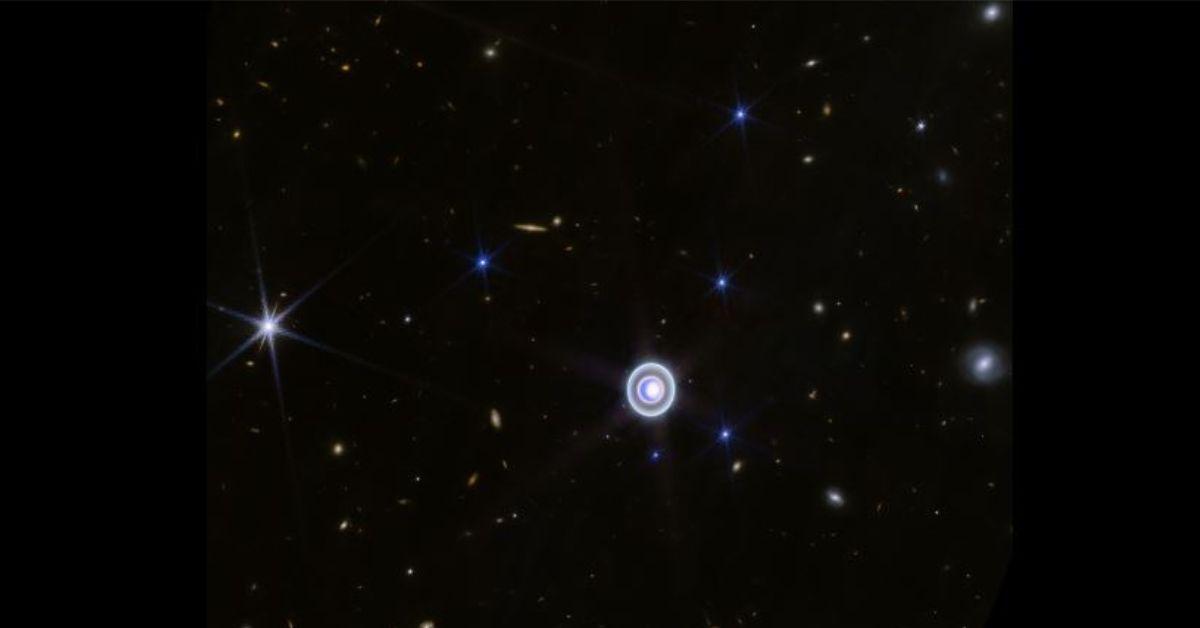Rings, Moons and Storms: Powerful Space Telescope Gives Stunning New Look at Icy Uranus

This image of Uranus from NIRCam (Near-Infrared Camera) on NASA’s James Webb Space Telescope captures Uranus’s seasonal north polar cap and dim inner and outer rings. This Webb image shows 9 of the planet’s 27 moons – clockwise starting at 2 o’clock: Rosalind, Puck, Belinda, Desdemona, Cressida, Bianca, Portia, Juliet, and Perdita.
Dec. 28 2023, Published 9:04 a.m. ET
With the help of the James Webb Space Telescope, NASA scientists have recently unveiled a captivating perspective of Uranus.
In a collection of new images, the dynamic world of the planet comes to life, showcasing its intricate features like rings, moons, storms, and atmospheric features — including a seasonal polar cap.
These photos, an extension of a two-color version released earlier this year, incorporate a broader range of wavelengths, providing an enriched understanding of the enigmatic planet.
Highlights include close-up images of the elusive Zeta ring, which is the faintest and closest to the planet, as well as comprehensive views of Uranus' faint inner and outer rings. The 27 known moons of the planet, some of which are located inside the rings, have also been photographed in stunning photos by the telescope.

This wide-field image of Uranus from NIRCam (Near-Infrared Camera) on NASA’s James Webb Space Telescope shows the planet amid a smattering of distant background galaxies. This image also includes 14 of the planet’s 27 moons: Oberon, Titania, Umbriel, Juliet, Perdita, Rosalind, Puck, Belinda, Desdemona, Cressida, Ariel, Miranda, Bianca, and Portia.
Our understanding of Uranus has fundamentally changed as a result of the James Webb Space Telescope, which has shown us that it is an odd and dynamic ice world with fascinating atmospheric features. This is in contrast to the earlier observations made by Voyager 2 in the 1980s, which showed Uranus as a calm, blue ball.
NASA said that the planet's seasonal north polar cloud cap is especially remarkable because it is clearly visible in the Webb photos. Clearer details, such the brilliant inner cap and the dark channel within the polar cap, become more visible towards lower latitudes as compared to earlier photos.
- Earth 2.0? Astronomers Discover Planet Nearly 9 Times Size of Ours with Possible Oceans and Habitable Conditions 120 Light Years Away
- Deep-Space Discovery: Powerful NASA Telescope Locates 'Ghostly' Remote Galaxy Enveloped in Cosmic Dust Clouds
- Blast from the Past: NASA Telescope Captures Vivid Image of Cosmic Fallout From Star That Exploded 3 Centuries Ago
The telescope has also captured images of vibrant storms near and below the southern border of the polar cap. NASA scientists speculate that the proximity of these storms may result from a combination of seasonal and meteorological factors.
Uranus exhibits the most extreme seasons in the solar system due to its unique axial tilt of approximately 98 degrees. As a consequence, parts of Uranus experience prolonged darkness for a quarter of its year, with sunlight concentrated over just one pole during a 21-year-long winter, according to NASA.
Never miss a story — sign up for the Front Page Detectives newsletter. Be on the scene the moment news breaks.
The James Webb Space Telescope is anticipated to deepen our understanding of Uranus' seasonal variations and the impact of storms on its atmosphere. NASA envisions that this newfound knowledge will not only contribute to future missions to Uranus but will also serve as a valuable reference for understanding other exoplanets of similar size.
In their news release, NASA emphasizes the significance of Uranus as an "exoplanet in our backyard," offering insights into the workings, meteorology and formation of planets comparable in size.
By placing our solar system in a broader context, studying Uranus becomes pivotal in advancing our understanding of the universe. The James Webb Space Telescope, instrumental in unveiling various celestial phenomena, continues to broaden our cosmic perspective.
Become a Front Page Detective
Sign up to receive breaking
Front Page Detectives
news and exclusive investigations.
